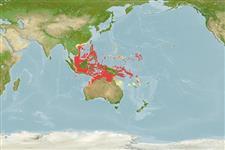Environment: milieu / climate zone / depth range / distribution range
Ökologie
seewasser riff-verbunden; standorttreu; tiefenbereich 5 - 147 m (Ref. 90102). Tropical; 22°N - 20°S, 104°E - 172°E
Indo-West Pacific: Philippines, Indonesia, New Guinea, northeastern Australia (Cape York to northern Great Barrier Reef) Belau, Truk, Caroline Islands, Marshall Islands, and the Solomon Islands. Reported from Malaysia (Ref. 5756).
Length at first maturity / Size / Gewicht / Alter
Maturity: Lm ?, range 42 - ? cm
Max length : 75.0 cm TL Männchen/unbestimmt; (Ref. 5222); max. veröff. Gewicht: 1.2 kg (Ref. 40637)
Rückenflossenstacheln (insgesamt) : 7 - 8; Rückenflossenweichstrahlen (insgesamt) : 10 - 12; Afterflossenstacheln: 3; Afterflossenweichstrahlen: 8.
Inhabits drop-offs and steep channel slopes (Ref. 9710). Very little has been published on its biology. Reported to forage in groups of two or three for rock- and sand living crustaceans and fishes. Rare in most areas (Ref. 9710). In the Hong Kong live fish markets (Ref. 27253).
Life cycle and mating behavior
Maturities | Fortpflanzung | Spawnings | Egg(s) | Fecundities | Larven
Heemstra, P.C. and J.E. Randall, 1993. FAO Species Catalogue. Vol. 16. Groupers of the world (family Serranidae, subfamily Epinephelinae). An annotated and illustrated catalogue of the grouper, rockcod, hind, coral grouper and lyretail species known to date. Rome: FAO. FAO Fish. Synop. 125(16):382 p. (Ref. 5222)
IUCN Rote Liste Status (Ref. 130435)
Bedrohung für Menschen
Reports of ciguatera poisoning (Ref. 5222)
Nutzung durch Menschen
Fischereien: weniger kommerziell
Tools
Zusatzinformationen
Download XML
Internet Quellen
Estimates based on models
Preferred temperature (Ref.
123201): 26.6 - 29.3, mean 28.7 °C (based on 1890 cells).
Phylogenetic diversity index (Ref.
82804): PD
50 = 0.5078 [Uniqueness, from 0.5 = low to 2.0 = high].
Bayesian length-weight: a=0.01023 (0.00643 - 0.01629), b=3.03 (2.90 - 3.16), in cm total length, based on LWR estimates for this species & (Sub)family-body (Ref.
93245).
Trophic level (Ref.
69278): 4.0 ±0.66 se; based on food items.
Widerstandsfähigkeit (Ref.
120179): niedrig, Verdopplung der Population dauert 4,5 - 14 Jahre. (Preliminary K or Fecundity.).
Fishing Vulnerability (Ref.
59153): Moderate to high vulnerability (50 of 100).
Nutrients (Ref.
124155): Calcium = 33.3 [19.4, 63.3] mg/100g; Iron = 0.563 [0.294, 0.941] mg/100g; Protein = 19 [17, 21] %; Omega3 = 0.162 [0.105, 0.257] g/100g; Selenium = 53.9 [31.7, 98.6] μg/100g; VitaminA = 42.2 [14.7, 134.2] μg/100g; Zinc = 0.813 [0.559, 1.195] mg/100g (wet weight);
